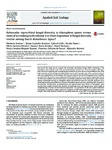Use este identificador para citar ou linkar para este item:
http://www.alice.cnptia.embrapa.br/alice/handle/doc/1030787Registro completo de metadados
| Campo DC | Valor | Idioma |
|---|---|---|
| dc.contributor.author | SOTERAS, F. | pt_BR |
| dc.contributor.author | MOREIRA, B. C. | pt_BR |
| dc.contributor.author | GRILLI, G. | pt_BR |
| dc.contributor.author | PASTOR, N. | pt_BR |
| dc.contributor.author | MENDES, F. C. | pt_BR |
| dc.contributor.author | MENDES, D. R. | pt_BR |
| dc.contributor.author | RENISON, D. | pt_BR |
| dc.contributor.author | KASUYA, M. C. M. | pt_BR |
| dc.contributor.author | SOUZA, F. A. de | pt_BR |
| dc.contributor.author | BECERRA, A. | pt_BR |
| dc.date.accessioned | 2017-06-06T23:53:59Z | - |
| dc.date.available | 2017-06-06T23:53:59Z | - |
| dc.date.created | 2015-12-07 | pt_BR |
| dc.date.issued | 2016 | pt_BR |
| dc.identifier.citation | Applied Soil Ecology, Amsterdam, v. 98, p. 272-277, 2016. | pt_BR |
| dc.identifier.uri | http://www.alice.cnptia.embrapa.br/alice/handle/doc/1030787 | pt_BR |
| dc.description | The aim of this study was to compare the arbuscular mycorrhizal fungal (AMF) community of the rhizosphere and inside the roots of the perennial Polylepis australis tree. Three forest types differing in their structural complexity due to anthropogenic disturbances were chosen at three different sites at the high mountains of central Argentina. Rhizosphere spores and P. australis roots of four randomly selected trees were isolated from 36 soil samples, DNA was extracted and the 18S rDNA fragments were amplified by nested-PCR. The products were analyzed by DGGE and the bands were excised for sequencing. In total, 36 OTUs were defined from 56 DGGE bands successfully sequenced. Forest disturbance types showed similar communities of AMF, as rhizosphere spores and within the roots of P. australis. However, DGGE clustering showed mainly differences between rhizosphere spores and root-colonizing AMF. Members of Glomeraceae, Pacisporaceae, Acaulosporaceae and Gigasporaceae were shown in rhizosphere spore samples. Root samples showed only members of Acaulosporaceae and Gigasporaceae, which might be complementary in terms of soil resources exploration. The prevalence of the root system with their community of symbionts might explain the resilience of AMF soil communities to forests structural changes. This study presents evidence of a possible preference in the AMF?P. australis interaction | pt_BR |
| dc.language.iso | eng | eng |
| dc.rights | openAccess | eng |
| dc.title | Arbuscular mycorrhizal fungal diversity in rhizosphere spores versus roots of an endangered endemic tree from Argentina: is fungal diversity similar among forest disturbance types? | pt_BR |
| dc.type | Artigo de periódico | pt_BR |
| dc.date.updated | 2017-09-26T11:11:11Z | pt_BR |
| dc.subject.thesagro | Micorriza | pt_BR |
| dc.subject.thesagro | Fungo | pt_BR |
| dc.subject.thesagro | Rizosfera | pt_BR |
| dc.subject.thesagro | Árvore | pt_BR |
| riaa.ainfo.id | 1030787 | pt_BR |
| riaa.ainfo.lastupdate | 2017-09-26 -03:00:00 | pt_BR |
| dc.identifier.doi | 10.1016/j.apsoil.2015.09.003 | pt_BR |
| dc.contributor.institution | FRANCISCO ADRIANO DE SOUZA, CNPMS. | pt_BR |
| Aparece nas coleções: | Artigo em periódico indexado (CNPMS)  | |
Arquivos associados a este item:
| Arquivo | Descrição | Tamanho | Formato | |
|---|---|---|---|---|
| Arbuscularmycorrhizal1.pdf | 957,53 kB | Adobe PDF |  Visualizar/Abrir |









